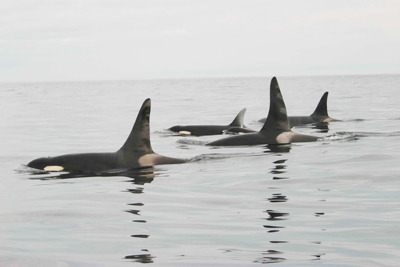The amount of critical habitat afforded to the Southern Resident killer whales will grow by leaps and bounds, if the Center for Biological Diversity has its way.
The Center last week filed a formal petition with the National Marine Fisheries Service to protect more critical habitat for the endangered Southern Resident population of killer whales. If successful, the proposal would extend Endangered Species Act protection to the whales’ winter foraging range off the coasts of Washington, Oregon and California.
That’s roughly 700 miles of coastline earmarked for protection in the Center’s petition, and the boundary would extend about 76 miles out to sea, the Center’s senior attorney Sarah Uhlemann said.
Uhlemann notes that new research, including satellite tracking data from the first half of 2013 (see map, at right) reveals that the whales travel extensively along the West Coast during the winter and early spring, regularly congregating near coastal rivers to feed on migrating salmon. The Center’s petition seeks to protect these areas off the coasts of Washington, Oregon and California as critical habitat.
“At this point we’re asking that the whales entire migratory path be included as critical habitat,” she said. “We know that Fisheries has had it on their mind and we’re hopeful the agency will agree with us.”
 In response to a petition from the Center and allies, the Fisheries Service determined in 2005 that Southern Residents are in danger of extinction. Although the agency has protected portions of the population’s summer habitat in the Puget Sound, important offshore habitat areas have recently been documented.
In response to a petition from the Center and allies, the Fisheries Service determined in 2005 that Southern Residents are in danger of extinction. Although the agency has protected portions of the population’s summer habitat in the Puget Sound, important offshore habitat areas have recently been documented.
Today, the population, which consists of the members of J,K and L pods, totals 81 animals, about four fewer than in 2005, the year the endangered listing was announced. The population, which most recently peaked at 99 in 1995, plummeted to 79 over the next six years, and has hovered in the mid-80s during its tenure on the U.S. Endangered Species Act.
The three biggest threats to the population’s long-term survival are lack of prey (salmon), pollution and disturbance from boats, according to NMFS.
In August, federal officials authorized spending roughly $900,000 for “on-the-water enforcement” for additional protection of the killer whales in response to a grant application by the Washington State Department of Fish and Wildlife
Critical habitat designations prevent the federal government from undertaking or approving activities that reduce an area’s ability to support an endangered species. Studies show that species with designated critical habitat are more than twice as likely to exhibit improving population trends than those without this additional protection.
“Killer whales are important to the identity and spirit of the Pacific Northwest, and beloved by people across the country,” Uhlemann said. “If this population of amazing, extremely intelligent animals is going to survive for future generations, we need to do more to protect their most important habitat.”



